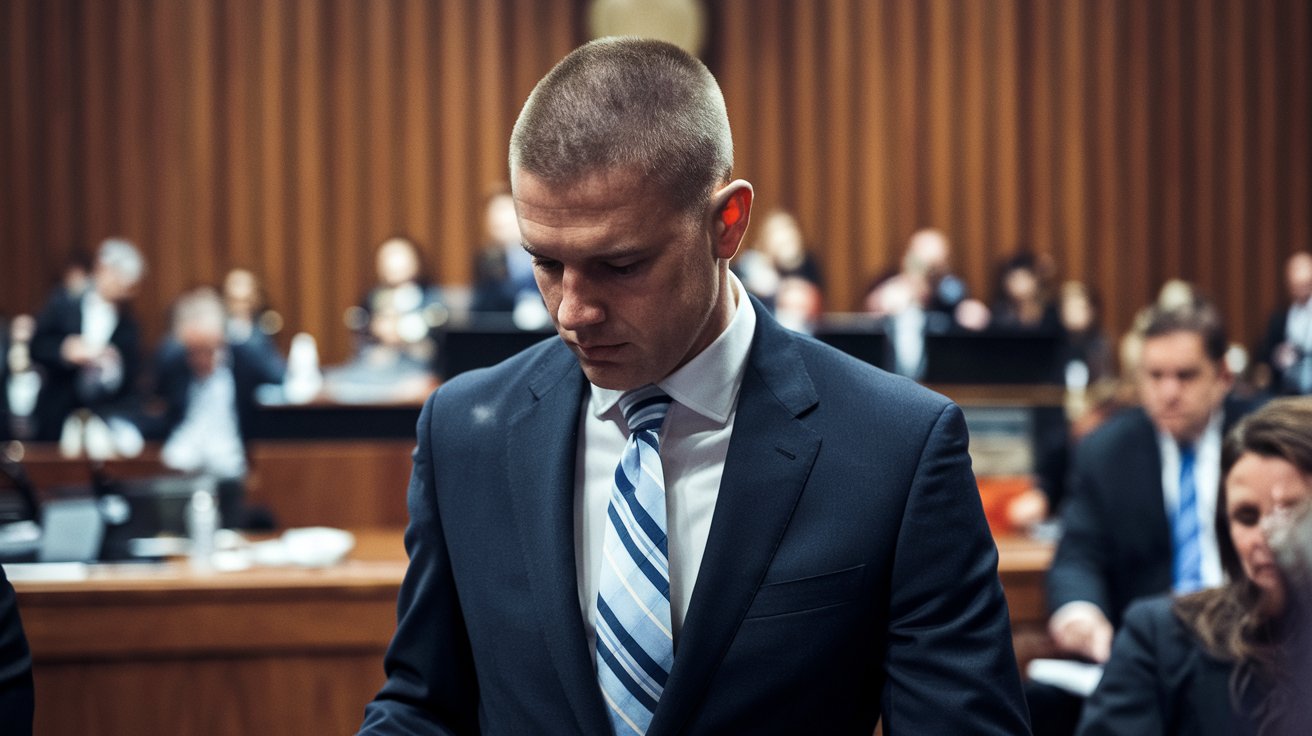
Who is Robert John Bardo? Robert John Bardo is a name that sends chills down the spine of anyone familiar with his story. Born on January 2, 1970, Bardo's life took a dark turn, leading to the tragic murder of 21-year-old actress Rebecca Schaeffer on July 18, 1989. His actions not only ended a promising young life but also brought significant changes to anti-stalking laws in the United States. From a troubled childhood marked by abuse and mental health issues to his obsessive fixation on celebrities, Bardo's story is a grim reminder of the dangers of unchecked obsession. Let's delve into the life and crimes of Robert John Bardo.
Key Takeaways:
- Robert John Bardo's tragic actions were influenced by a turbulent upbringing, mental health struggles, and an unhealthy obsession with celebrities, leading to the murder of actress Rebecca Schaeffer.
- The murder of Rebecca Schaeffer led to changes in anti-stalking laws and raised awareness about the dangers of celebrity obsession, leaving a lasting impact on society and the entertainment industry.
Early Life and Family Dynamics
Robert John Bardo's early years were marked by instability and challenges. Understanding his background provides insight into the factors that shaped his later actions.
-
Robert John Bardo was born on January 2, 1970, in the United States. He was the youngest of seven children, with a mother of Japanese descent and a father who served as a non-commissioned officer in the United States Air Force.
-
Bardo's family moved frequently due to his father's military career. This constant relocation contributed to his unstable upbringing, making it difficult for him to form lasting friendships and a sense of belonging.
-
Bardo experienced physical and emotional abuse at the hands of one of his siblings. This traumatic experience had a lasting impact on his mental health and behavior.
-
Due to his abusive home environment, Bardo was placed in foster care. However, this temporary solution did not address the deeper issues he faced, and he continued to struggle.
-
Bardo's family had a history of mental illness. He was diagnosed with bipolar disorder, which would later be cited as a factor in his actions.
Struggles with Mental Health and Education
Bardo's mental health issues and educational struggles further complicated his life, leading to a series of unfortunate events.
-
At the age of 15, Bardo was institutionalized for a month to treat his emotional problems. Despite this intervention, his behavior continued to deteriorate.
-
Bardo dropped out of Pueblo Magnet High School in the ninth grade. This decision marked the beginning of his downward spiral into a life of menial jobs and increasing instability.
-
After dropping out of school, Bardo began working as a janitor at Jack in the Box. This job provided him with minimal income and no social interaction, further exacerbating his mental health issues.
Escalating Behavior and Obsession with Celebrities
Bardo's behavior became increasingly erratic, and his obsession with celebrities took a dangerous turn.
-
In the 18 months leading up to Schaeffer's murder, Bardo was arrested three times. His offenses included domestic violence and disorderly conduct, highlighting his erratic behavior and lack of impulse control.
-
Days before traveling to Los Angeles, Bardo threatened his neighbors who were throwing a party across the street. He yelled, "If you don’t shut up, I’m going to get my .357 magnum and shoot you!" This outburst demonstrated his escalating aggression.
-
Bardo's life revolved around famous women. He wrote fan mail, drew portraits, and stalked various celebrities, including child peace activist Samantha Smith and pop stars Tiffany and Debbie Gibson.
-
Bardo's attempts to stalk Samantha Smith failed when he was discouraged by a run-in with state police over a traffic offense. This setback did not deter him from pursuing other celebrities.
The Obsession with Rebecca Schaeffer
Rebecca Schaeffer became the focus of Bardo's dangerous fixation, leading to tragic consequences.
-
Rebecca Schaeffer was a 21-year-old actress who starred in the CBS television series "My Sister Sam." Bardo became obsessed with her after watching the show and began writing her fan mail.
-
Bardo wrote numerous letters to Schaeffer and even drew portraits of her. These actions were part of his fixation on the actress, which he could not shake off.
-
Bardo attempted to gain access to the set of "My Sister Sam," but was denied entrance by security. Despite this, he continued to pursue Schaeffer, eventually obtaining her home address through a private investigator.
-
Bardo paid $250 to a private investigator to obtain Schaeffer's home address from the California Department of Motor Vehicles (DMV) records. This information was crucial in his plan to confront her.
The Tragic Murder
The events leading up to and following the murder of Rebecca Schaeffer were shocking and heartbreaking.
-
On July 18, 1989, Bardo arrived at Schaeffer's home in West Hollywood. He was carrying a card she had sent him, her photo, and a copy of "The Catcher in the Rye," the same book Mark David Chapman was carrying when he murdered John Lennon.
-
When Schaeffer answered the door, she greeted Bardo, smiled, and told him, "Please take care." However, this gesture did not satisfy him. He returned an hour later, armed with a .357 magnum pistol.
-
Bardo shot Schaeffer directly in the heart when she opened the door again. He later described the scene to psychiatrist Dr. Park Dietz, stating that Schaeffer was screaming "Why, why?" as he fired the gun.
-
Following the murder, Bardo fled the scene and was later found running down the freeway in Tucson. He was arrested and held on a one-million-dollar bail.
Trial, Conviction, and Prison Life
Bardo's trial and subsequent life in prison reveal the complexities of his mental health and the justice system's response.
-
During his trial, Bardo's attorneys argued that he was mentally ill and incapable of planning the murder. However, prosecutor Marcia Clark presented evidence that Bardo had stalked Schaeffer for two years before committing the crime. The jury found Bardo guilty of first-degree murder, and he was sentenced to life in prison without the possibility of parole.
-
The defense team claimed that Bardo's schizophrenia was the primary cause of his actions. However, forensic psychiatrist Dr. Park Dietz testified that while Bardo had schizophrenia, he was not legally insane. This distinction was crucial in determining Bardo's culpability.
-
Bardo claimed that the U2 song "Exit" influenced his decision to kill Schaeffer. During the trial, the song was played in the courtroom, with Bardo lip-synching the lyrics. This unusual testimony highlighted his fixation on music and its role in his actions.
-
Bardo is currently incarcerated at Avenal State Prison in California. In prison, he spends much of his time drawing portraits of celebrities, including film stars and musicians. Some of these drawings are available for purchase online.
-
Bardo's drawings range from those of film stars like Angelina Jolie to notorious killers such as David Berkowitz and John Wayne Gacy. This activity suggests that despite his incarceration, he continues to be fascinated by the world of celebrities.
-
In recent years, Bardo has attempted to rebrand himself as an expert on psychological derangements. He wrote to Joseph Dalu, a Laguna Hills private investigator and threat assessment expert, expressing his desire to correspond on the issue of stalking behavior.
-
Dalu considered the possibility that Bardo had genuine intentions to shed light on the mentality of stalkers. However, he also expressed concern about Bardo becoming a celebrity again, highlighting the complexities of engaging with someone convicted of such a heinous crime.
Impact and Legacy
The murder of Rebecca Schaeffer had far-reaching effects, leading to changes in laws and raising awareness about stalking.
-
Rebecca Schaeffer's murder led to significant changes in anti-stalking laws. In 1990, California passed the first anti-stalking law in the country, officially labeling stalking a crime. This legislation was a direct response to Schaeffer's tragic death and the subsequent investigation into Bardo's actions.
-
The Screen Actors Guild pushed for stronger protections against the misuse of personal information held by the DMV. This effort culminated in the passage of the Driver’s Privacy Protection Act in 1994, which required every state to restrict access to such information.
-
Rebecca Schaeffer's death was not just a personal tragedy but also a catalyst for broader societal change. Her castmates from "My Sister Sam" created a PSA about preventing handgun violence, and Pam Dawber testified before Congress on implementing common-sense gun laws.
-
Over 200 mourners attended Schaeffer's funeral at Ahavai Sholom Cemetery in Portland, Oregon. Condolences poured in from those whose lives were touched by her during her short time on earth.
-
Psychiatrist Dr. Park Dietz analyzed Bardo's behavior and motivations. Bardo described feeling a special connection to Schaeffer and identified with Mark David Chapman, John Lennon's killer. Both men carried a copy of "The Catcher in the Rye" when they committed their crimes.
-
In 2007, while at Mule Creek State Prison in Amador County, Bardo was stabbed 11 times by another inmate on his way to breakfast. He received treatment at UC Davis Medical Center and made a full recovery.
-
Bardo is now 54 years old and remains incarcerated at Avenal State Prison in California. Despite his life sentence, he continues to draw portraits and express his remorse for Schaeffer's death.
-
In a recent interview, Bardo reflected on Schaeffer's death, stating, "She was irreplaceable. I think about her every day because she should be here." This poignant statement underscores the profound impact of his actions and the enduring memory of Rebecca Schaeffer.
Lessons from a Tragic Tale
Robert John Bardo's story is a chilling reminder of the dangers of obsession and stalking. His actions led to the tragic death of Rebecca Schaeffer, a promising young actress, and sparked significant changes in anti-stalking laws. Bardo's troubled past, marked by abuse and mental health issues, highlights the need for better support systems. His fixation on celebrities and eventual crime underscore the importance of protecting personal information. Schaeffer's death wasn't in vain; it led to the creation of laws that help protect others from similar fates. As we remember Rebecca Schaeffer, we also acknowledge the profound impact her death had on society. This case serves as a stark warning about the consequences of unchecked mental illness and celebrity obsession. Let's honor her memory by continuing to advocate for stronger protections and mental health awareness.
Frequently Asked Questions
Was this page helpful?
Our commitment to delivering trustworthy and engaging content is at the heart of what we do. Each fact on our site is contributed by real users like you, bringing a wealth of diverse insights and information. To ensure the highest standards of accuracy and reliability, our dedicated editors meticulously review each submission. This process guarantees that the facts we share are not only fascinating but also credible. Trust in our commitment to quality and authenticity as you explore and learn with us.


